USS LST-340, the afternoon of 16 June 1943, Tenaru Beach, Guadalcanal, Solomon Islands.
After attempting unsuccessfully to unload her cargo of military vehicles and troops at Koli Point beach, LST-340 was ordered due west along the northern coast of
the Island towards Kukum beach on the western side of Lunga Point. About half way to her destination she was attacked by nine Japanese Aichi D3A "Val" dive bombers. Nine bombs were
dropped from three planes. The others strafed the ship. One plane's bomb (of three) hit the main deck at frame 30, near the after cargo hatch on the port side of center line, the
other two were near misses. It was shot down by number six 20mm. A second plane scored two near misses and strafed the bow guns. This resulted in over 100 holes to the ship's hull
on the port side. This aircraft was also shot down by the forward guns. The second attack resulted in the death of one member of the forward gun crew and wounded of two. Nine U.S.
Army troops were also killed in this attack. The direct bomb hit created a terrific fire among the trucks, which all were full of fuel, cans of oil, gasoline, wooden crates, trunks,
bedding and barracks bags. The water main and all interior communications were knocked out. All troop passengers were ordered to abandon ship. Because of the fire, the auxiliary
engine room was abandoned. The port engine failed. The starboard engine throttle was put into flank speed and all personnel (other than gun crews and repair party were ordered to
abandon ship). The ship headed for Tenaru Beach and at about 500 yards from the shore the starboard engine cut out and the ship's momentum beached her with the help of the wind.
Ref. USS LST-340-Action Report 6/16/43, pages 1-3; National Archives ID 134284080, roll A435. and COM LST FLOT 5 War Diary, 6/1-30/43. |
Click On Image
For Full Size Image |
Size |
Image Description |
Source |
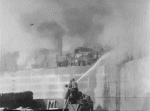
1016034029 |
313k |
USS LST-340 on fire with LCT(5)-58 fighting the fire on the starboard side.
Frames from a short film called "LST NO 340 Bombed By Japanese Off Guadalcanal, Solomon Islands, SW Pacific" Dept. of the Army. National Archives ID 15648.
Local ID 111-ADC-1842 |
David Upton |
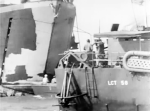
1016034030 |
120k |
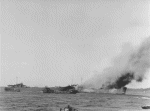
1016034031 |
280k |
USS LST-340 on fire with USS LST-398 and LCT(5)-58 fighting the fire on the starboard side.
Frames from a short film called "LST NO 340 Bombed By Japanese Off Guadalcanal, Solomon Islands, SW Pacific" Dept. of the Army. National Archives ID 15648.
Local ID 111-ADC-1842 |
David Upton |
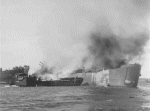
1016034032 |
304k |
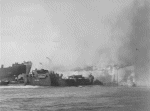
1016034033 |
133k |
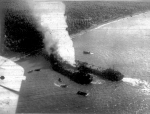
1016034007 |
341k |
USS LST-340 on fire after beaching on Tenaru Beach, Guadalcanal the afternoon of 16 June 1943, after being dive bombed off the north coast
of Guadalcanal. LST-340 beached here and with the assistance of USS LST-398, on LST-340's starboard quarter,
and USS LST-353, on LST-340's port quarter, fought a massive fire, saving the ship.
1016034007 - Photo from the LST-340-Action Report 6/16/43, page 5; National Archives ID 134284080, roll A435
1016034034 - U.S. National Archives and Records Administration photo # 80-G-213382 from the collections U.S Naval History and Heritage Command |
David Upton
Robert Hurst |
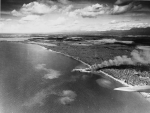
1016034034 |
341k |
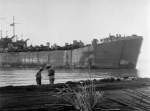
1016034028 |
123k |
USS LST-340 on Tenaru Beach, Guadalcanal the afternoon of 16 June 1943, After four hours the fire was finally put out.
Frame from the short film "LST NO 340 Bombed By Japanese Off Guadalcanal, Solomon Islands, SW Pacific" Dept. of the Army. National Archives ID 15648. Local ID 111-ADC-1842.
|
David Upton |
On July 29 1944, USS LST-340 was pushed up on to a reef and stranded at "White Beach 2" on Tinian Island. She had dropped off
24 trucks and drivers at the temporary pier visible in 80-G-284218 and picked up a large number of US casualties who were being evacuated for medical treatment. While
retracting from the beach large waves and winds from the edges of a typhoon broached the ship and then ran her hard aground on the reef. Her starboard propeller shaft was
knocked five inches out of alignment and the main engine room flooded beyond control - the auxiliary engine room was flooded two feet deep with a four foot coralhead
intruding through a hole punched through the ship's hull. The wind and waves were so strong that the temporary pier on the beach nearby was broken apart later that
evening and destroyed, leaving the beachhead serviceable only by DUKWs and LVTs.
Boats from USS Cambria (APA-36) were initially sent to assist the next day but the surf was
still too rough to transfer the wounded solders. The task then fell to the time-tested but unnerving Breeches Buoy. 160 casualties were removed one at a time by breeches
buoy to USS Chickasaw (ATF-83) over the course of eight and a half hours on July 30 and
then transferred to USS LST-40. Chickasaw left to assist other vessels in need of towing services and was replaced
by USS Clamp (ARS-33) who began repair and salvage operations on August 1. She was refloated
early on the morning of Sunday, August 13 after nearly two weeks work and towed by Chickasaw to Tanapag Harbor, Saipan. A Navy inspection revealed her to
be beyond economic repair and she was turned into an unpowered barracks ship.
Contributed by Tracy White |
Click On Image
For Full Size Image |
Size |
Image Description |
Source |
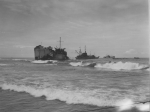
80-G-284213 |
200k |
USS LST-340 aground with USS Chickasaw (ATF-83) and
likely USS Chichona (AN-12) during breeches buoy recovery of the casualties aboard the
grounded ship. Note the LCVP rolling away from her stern as a wave passes and washes down the hull.
US National Archives photo # 80-G-284213 |
Tracy White |
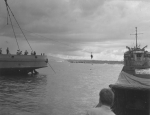
80-G-284217 |
102k |
A soldier is transferred from USS LST-340's stern to USS Chickasaw (ATF-83)
via breeches buoy as seen from a LCVP.
US National Archives photo # 80-G-284217 |
Tracy White |
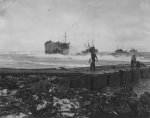
80-G-284218 |
187k |
USS LST-340 aground with USS Chickasaw (ATF-83)
and likely USS Chichona (AN-12) anchored further out. The attack transport in the distance is
most likely USS Cambria (APA-36) as she was close enough that her boats responded to the
grounding (and may be in view here) and the dazzle pattern matches the camouflage Measure 32 pattern 3D. Note the wave breaking over LST-340's aft boat davit.
US National Archives photo # 80-G-284218 |
Tracy White |

80-G-284222 |
160k |
A starboard view of USS LST-340 from the shoreline of White Beach 2 as she lay stranded on 30 July.
US National Archives photo # 80-G-284222 |
Tracy White |

80-G-284223 |
196k |
USS LST-340's well-weathered aft half during breeches buoy operations on July 30.
US National Archives photo # 80-G-284223 |
Tracy White |
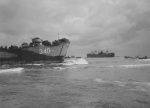
80-G-284224 |
152k |
USS LST-340's bow when grounded showing the three forward single-barrel 40mm mounts and two of her forward 20mm
mounts under protective canvas due to the weather. The two different sizes of hull number were due to different directives concerning the size of numbers on various
classes of ship.
US National Archives photo # 80-G-284224 |
Tracy White |
USS LST-340 / USS Spark (IX-196)
Dictionary of American Naval Fighting Ships (DANFS)
Commanding Officers
|
| 01 | LT. Villella, William, USN | 26 December 1942 - August 1943 |
| 02 | ENS. Haskell, Leroy, USNR | August 1943 - ? |
|
|
| Courtesy Wolfgang Hechler and Ron Reeves |
Crew Contact And Reunion Information
U.S. Navy Memorial Foundation - Navy Log
Additional Resources and Web Sites of Interest
LST Flotilla Five War Diary May 1944
Photos of LST-340 on fire at Tenaru Beach, Guadalcanal, 16 June 1943
The USS LST Ship Memorial
LST Home Port
State LST Chapters
United States LST Association
This page is created and maintained by Gary P. Priolo

|
Last Updated 10 November 2023













